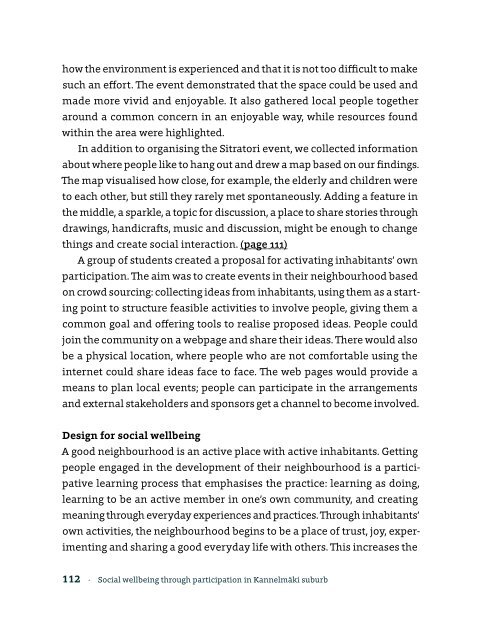Designing for wellbeing
Designing for wellbeing
Designing for wellbeing
You also want an ePaper? Increase the reach of your titles
YUMPU automatically turns print PDFs into web optimized ePapers that Google loves.
how the environment is experienced and that it is not too difficult to make<br />
such an ef<strong>for</strong>t. The event demonstrated that the space could be used and<br />
made more vivid and enjoyable. It also gathered local people together<br />
around a common concern in an enjoyable way, while resources found<br />
within the area were highlighted.<br />
In addition to organising the Sitratori event, we collected in<strong>for</strong>mation<br />
about where people like to hang out and drew a map based on our findings.<br />
The map visualised how close, <strong>for</strong> example, the elderly and children were<br />
to each other, but still they rarely met spontaneously. Adding a feature in<br />
the middle, a sparkle, a topic <strong>for</strong> discussion, a place to share stories through<br />
drawings, handicrafts, music and discussion, might be enough to change<br />
things and create social interaction. (page 111)<br />
A group of students created a proposal <strong>for</strong> activating inhabitants’ own<br />
participation. The aim was to create events in their neighbourhood based<br />
on crowd sourcing: collecting ideas from inhabitants, using them as a starting<br />
point to structure feasible activities to involve people, giving them a<br />
common goal and offering tools to realise proposed ideas. People could<br />
join the community on a webpage and share their ideas. There would also<br />
be a physical location, where people who are not com<strong>for</strong>table using the<br />
internet could share ideas face to face. The web pages would provide a<br />
means to plan local events; people can participate in the arrangements<br />
and external stakeholders and sponsors get a channel to become involved.<br />
Design <strong>for</strong> social <strong>wellbeing</strong><br />
A good neighbourhood is an active place with active inhabitants. Getting<br />
people engaged in the development of their neighbourhood is a participative<br />
learning process that emphasises the practice: learning as doing,<br />
learning to be an active member in one’s own community, and creating<br />
meaning through everyday experiences and practices. Through inhabitants’<br />
own activities, the neighbourhood begins to be a place of trust, joy, experimenting<br />
and sharing a good everyday life with others. This increases the<br />
112 · Social <strong>wellbeing</strong> through participation in Kannelmäki suburb
















